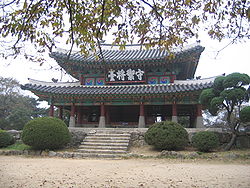Gwangju[a] (Korean: 광주; Korean pronunciation: [kwaŋ.dʑu]) is a city in Gyeonggi Province, South Korea, a suburb southeast of Seoul. The city is not to be confused with the much larger Gwangju Metropolitan City, former capital of South Jeolla Province, or Guangzhou, the city of Guangdong, China in Hanja.
Gwangju 광주시 | |
|---|---|
| Korean transcription(s) | |
| • Hangul | 광주시 |
| • Hanja | 廣州市[1] |
| • Revised Romanization | Gwangju-si |
| • McCune-Reischauer | Kwangju-si |
 | |
 Location in South Korea | |
| Country | |
| Region | Gyeonggi Province (Sudogwon) |
| Administrative divisions | 2 eup, 10 dong, 4 myeon |
| Government | |
| • mayor | Sehwan Bang (방세환) |
| Area | |
| • Total | 430.99 km2 (166.41 sq mi) |
| Population (October, 2022) | |
| • Total | 391,722 |
| • Density | 910/km2 (2,400/sq mi) |
| • Dialect | Seoul |
History
editBunwon-ri in Gwangju took an important role of ceramic production during the Kingdom of Joseon. There had official kilns and produced superb quality of white porcelains for use at the royal court and to export to China.[3]
In 1962, 4 myeons (townships) including 5 ris (villages) were incorporated to Seoul.[4]
In 1973, 6 ris were separated and became a part of Seongnam city. In 1979, Gwangju-myeon was elevated to an eup. Gwangju county became a city in 2001.[5]
Festival
editGwangju Toechon Tomato Festival - Gwangju City, Gyeonggi Province has been holding a festival since 2003 to promote the city's pollution-free tomatoes and sell them to consumers. [1]
Climate
editGwangju has a monsoon-influenced humid continental climate (Köppen: Dwa) with cold, dry winters and hot, rainy summers.
| Climate data for Gwangju, Gyeonggi (1993–2020 normals) | |||||||||||||
|---|---|---|---|---|---|---|---|---|---|---|---|---|---|
| Month | Jan | Feb | Mar | Apr | May | Jun | Jul | Aug | Sep | Oct | Nov | Dec | Year |
| Mean daily maximum °C (°F) | 2.2 (36.0) | 5.4 (41.7) | 11.7 (53.1) | 18.6 (65.5) | 23.9 (75.0) | 27.8 (82.0) | 29.2 (84.6) | 30.2 (86.4) | 26.0 (78.8) | 20.0 (68.0) | 11.9 (53.4) | 3.9 (39.0) | 17.6 (63.7) |
| Daily mean °C (°F) | −3.3 (26.1) | −0.4 (31.3) | 5.3 (41.5) | 11.8 (53.2) | 17.2 (63.0) | 21.8 (71.2) | 24.7 (76.5) | 25.2 (77.4) | 20.2 (68.4) | 13.3 (55.9) | 6.1 (43.0) | −1.4 (29.5) | 11.7 (53.1) |
| Mean daily minimum °C (°F) | −8.2 (17.2) | −5.7 (21.7) | −0.5 (31.1) | 5.5 (41.9) | 11.2 (52.2) | 16.8 (62.2) | 21.2 (70.2) | 21.6 (70.9) | 16.0 (60.8) | 8.2 (46.8) | 1.0 (33.8) | −6.1 (21.0) | 6.8 (44.2) |
| Average precipitation mm (inches) | 16.6 (0.65) | 25.0 (0.98) | 35.5 (1.40) | 67.5 (2.66) | 91.4 (3.60) | 118.1 (4.65) | 374.4 (14.74) | 317.6 (12.50) | 140.5 (5.53) | 55.9 (2.20) | 45.8 (1.80) | 19.8 (0.78) | 1,308.1 (51.50) |
| Average precipitation days (≥ 0.1 mm) | 3.4 | 3.5 | 5.3 | 6.8 | 6.6 | 7.6 | 12.9 | 13.0 | 7.5 | 5.2 | 6.8 | 4.8 | 83.4 |
| Source: Korea Meteorological Administration[6] | |||||||||||||
Notable people
edit- Ahn Sun-ju (1987), professional golfer
- Kim Yu-bin (1988), singer and actress
- Choi Soo-young (1990), singer and actress, member of Girls' Generation.
- Lee Hong-gi (1990), singer and actor
- Lee Hye-ri (1994), singer and actress
- Julio Ko (1970), kayaker and educator
- Yoon Shi-yoon (1986), actor and variety entertainer
- Hyungwon (1994), member of boy group Monsta X
- Lee Ju-yeon (1998), member of boy group The Boyz
International relations
editSister cities
editFriendship cities
edit Faku County, Liaoning, China
Faku County, Liaoning, China Dornogovi Province, Mongolia
Dornogovi Province, Mongolia Bathurst, New South Wales, Australia
Bathurst, New South Wales, Australia
See also
editNotes
editReferences
editCitations
editBibliography
edit- , 'Encyclopædia Britannica, 9th ed., Vol. VI, New York: Charles Scribner's Sons, 1878, pp. 390–394.
External links
edit- City government website (in English)
- City Council website Archived 2019-04-03 at the Wayback Machine (in Korean)
37°22′N 127°17′E / 37.367°N 127.283°E





